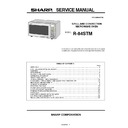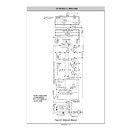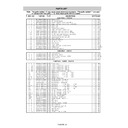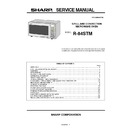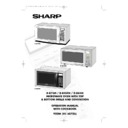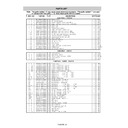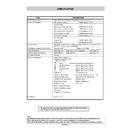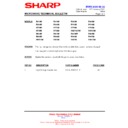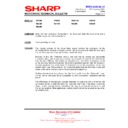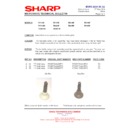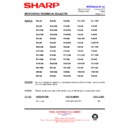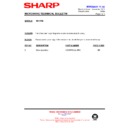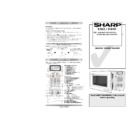Sharp R-84ST (serv.man3) Service Manual ▷ View online
R-84STM - 17
COMPONENT REPLACEMENT AND ADJUSTMENT
DOOR REPLACEMENT
REMOVAL
Figure C-5. Door Disassembly
1. CARRY OUT 3D CHECKS.
2. Push the open button and open the door slightly.
3. Insert a putty knife (thickness of about 0.5mm) into the
2. Push the open button and open the door slightly.
3. Insert a putty knife (thickness of about 0.5mm) into the
gap between the choke cover and door frame as shown
in Figure C-5 to free engaging parts.
in Figure C-5 to free engaging parts.
4. Release choke cover from door panel.
5. Now choke cover is free.
6. Lift the door upwards.
7. Now, door sub assembly is free from oven cavity.
8. Remove the four (4) screws holding the door panel to the
5. Now choke cover is free.
6. Lift the door upwards.
7. Now, door sub assembly is free from oven cavity.
8. Remove the four (4) screws holding the door panel to the
door frame.
9. Release door panel from six (6) tabs of door frame by
sliding door panel downward.
10. Now, door panel is free.
11. Slide latch head upward and remove it from door frame
11. Slide latch head upward and remove it from door frame
with releasing latch spring from door frame and latch
head.
head.
12. Now, latch head and latch spring are free.
13. Remove the two (2) screws holding the glass stopper to
13. Remove the two (2) screws holding the glass stopper to
the door frame.
14. Remove the glass stopper from the door frame.
15. Slide the front door glass leftwards and then slide
15. Slide the front door glass leftwards and then slide
downwards to release the tabs holding it.
16. Now, the front door glass is free
RE-INSTALL
1. Re-install the front door glass to the door frame as follows.
1. Re-install the front door glass to the door frame as follows.
Insert the upper edge of the front door glass into the six
(6) tabs of the door frame.
(6) tabs of the door frame.
a) Slide the front door glass downwards and insert the lower
edge of the front door glass into the six (6) tabs of the door
frame.
frame.
b) Slide the front door glass rightwards and insert the right
edge of the front door glass into the one (1) tab of the door
frame.
frame.
2. Re-install the glass stopper o the door frame as follows.
Re-install the glass stopper to the door frame so that the
two (2) holes of the glass stopper meet the two (2) pins of
the door frame.
two (2) holes of the glass stopper meet the two (2) pins of
the door frame.
a) Hold the glass stopper to the door frame with the two (2)
screws.
3. Re-install the latch spring to the latch head. Re-install the
latch spring to the door frame. Re-install latch head to
door frame.
door frame.
4. Re-install door panel to door frame by fitting six (6) tabs
of door frame to six (6) holes of door panel.
5. Hold the door panel to the door frame with four (4) screws.
6. Locate door panel hinge pins into cavity hinge location
6. Locate door panel hinge pins into cavity hinge location
holes.
7. Re-install choke cover to door panel by clipping into
position.
Note: After any service to the door;
(A) Make sure that door sensing switch and primary
latch switch are operating properly. (Refer to chapter
"Test Procedures".).
"Test Procedures".).
(B) An approved microwave survey meter should be
used to assure compliance with proper microwave
radiation emission limitation standards. (Refer to
Microwave Measurement Procedure.)
radiation emission limitation standards. (Refer to
Microwave Measurement Procedure.)
After any service, make sure of the following :
1. Door latch heads smoothly catch latch hook through latch
1. Door latch heads smoothly catch latch hook through latch
holes and that latch head goes through centre of latch
hole.
hole.
2. Deviation of door alignment from horizontal line of cavity
face plate is to be less than 1.0mm.
3. Door is positioned with its face pressed toward cavity
face plate.
4. Check for microwave leakage around door with an
approved microwave survey meter. (Refer to Microwave
Measurement Procedure.)
Measurement Procedure.)
Note:
The door on a microwave oven is designed to act as
an electronic seal preventing the leakage of
microwave energy from oven cavity during cook
cycle. This function does not require that door be air-
tight, moisture (condensation)-tight or light-tight.
Therefore, occasional appearance of moisture, light
or sensing of gentle warm air movement around
oven door is not abnormal and do not of themselves,
indicate a leakage of microwave energy from oven
cavity.
an electronic seal preventing the leakage of
microwave energy from oven cavity during cook
cycle. This function does not require that door be air-
tight, moisture (condensation)-tight or light-tight.
Therefore, occasional appearance of moisture, light
or sensing of gentle warm air movement around
oven door is not abnormal and do not of themselves,
indicate a leakage of microwave energy from oven
cavity.
Figure C-6. Door Replacement
NOTE: When carrying out any repair to the door,
do not bend or warp the slit choke (tabs on
the door panel assembly) to prevent
microwave leakage.
the door panel assembly) to prevent
microwave leakage.
10
5
4
12
8
7
9
11
3
2
1
Choke Cover
Door Frame
Putty Knife
6
Pin
Pin
Lower
Oven
Hinge
Oven
Hinge
Lower Oven
Hinge
Hinge
Upper
Oven
Hinge
Oven
Hinge
Upper Oven
Hinge
Hinge
Door Panel
Choke Cover
Slit Choke
R-84STM - 18
MICROWAVE MEASUREMENT
After any repair, the microwve oven must be checked
for microwave leakage to ensure continued safe
operation. BS EN 60335-2-25 specifies that the
maximum permitted leakage with a load of 275ml is 50
W/m
for microwave leakage to ensure continued safe
operation. BS EN 60335-2-25 specifies that the
maximum permitted leakage with a load of 275ml is 50
W/m
2
(equivalent to 5mW/cm
2
) at a distance of 5cm
from the oven.
PREPARATION
The following items are required to carry out this test:-
1.
1.
A low form of 600ml beaker made from
electrically non-conductive material, such as
glass or plastic, with an inside diameter of
approximately 8.5cm. This must contain 275
electrically non-conductive material, such as
glass or plastic, with an inside diameter of
approximately 8.5cm. This must contain 275
±
15ml of water, at an initial temperature of 20
±
2
°C.
2.
A leakage detector which has been calibrated
within the preceeding 12 months to a stand
whose accuracy can be traced to National
Physical Laboratory Standards.
within the preceeding 12 months to a stand
whose accuracy can be traced to National
Physical Laboratory Standards.
Recommended instruments are:
Apollo "XI"
Celtec "A1000"
Celtec "A1000"
Before commencing the test, check the leakage
detector is functioning and adjusted according to the
manufacturer's instructions, and any spacers are fitted
to ensure that measurement is taken 5cm from the
surface of the oven.
detector is functioning and adjusted according to the
manufacturer's instructions, and any spacers are fitted
to ensure that measurement is taken 5cm from the
surface of the oven.
Dotted line indicaes path taken by the leakage detector
Whilst the maximum leakage permitted in BS EN 60335-2-25 is 50 W/m
2
(equivalent to 5mW/cm
2
), it is not
normal to detect anything signifcant, and therefore any detected leakage should be investigated.
PROCEDURE
1.
Place the beaker containing the water load
inthe oven cavity at the centre of the
turntable. The placing of this standard load in
the oven is important, not only to protect the
oven, but also to ensure that any leakage it is
not disguised by too large a load absorbing
the energy.
inthe oven cavity at the centre of the
turntable. The placing of this standard load in
the oven is important, not only to protect the
oven, but also to ensure that any leakage it is
not disguised by too large a load absorbing
the energy.
2.
Close the oven door, and with the power level
set to FULL, turn the oven ON with the timer
set for a few minutes operation. Should the
water begin to boil before the test has benn
completed, it should be replaced.
set to FULL, turn the oven ON with the timer
set for a few minutes operation. Should the
water begin to boil before the test has benn
completed, it should be replaced.
3.
As shown in the diagram below, move the
probe slowly (not faster than 2.5cm/sec);-
probe slowly (not faster than 2.5cm/sec);-
a)
around the edge of the door following the gap
b)
across the face of the door
c)
across any vents in the oven's sides, rear or
top
top
R-84STM - 18
MICROWAVE MEASUREMENT
After any repair, the microwve oven must be checked
for microwave leakage to ensure continued safe
operation. BS EN 60335-2-25 specifies that the
maximum permitted leakage with a load of 275ml is 50
W/m
for microwave leakage to ensure continued safe
operation. BS EN 60335-2-25 specifies that the
maximum permitted leakage with a load of 275ml is 50
W/m
2
(equivalent to 5mW/cm
2
) at a distance of 5cm
from the oven.
PREPARATION
The following items are required to carry out this test:-
1.
1.
A low form of 600ml beaker made from
electrically non-conductive material, such as
glass or plastic, with an inside diameter of
approximately 8.5cm. This must contain 275
electrically non-conductive material, such as
glass or plastic, with an inside diameter of
approximately 8.5cm. This must contain 275
±
15ml of water, at an initial temperature of 20
±
2
°C.
2.
A leakage detector which has been calibrated
within the preceeding 12 months to a stand
whose accuracy can be traced to National
Physical Laboratory Standards.
within the preceeding 12 months to a stand
whose accuracy can be traced to National
Physical Laboratory Standards.
Recommended instruments are:
Apollo "XI"
Celtec "A1000"
Celtec "A1000"
Before commencing the test, check the leakage
detector is functioning and adjusted according to the
manufacturer's instructions, and any spacers are fitted
to ensure that measurement is taken 5cm from the
surface of the oven.
detector is functioning and adjusted according to the
manufacturer's instructions, and any spacers are fitted
to ensure that measurement is taken 5cm from the
surface of the oven.
Dotted line indicaes path taken by the leakage detector
Whilst the maximum leakage permitted in BS EN 60335-2-25 is 50 W/m
2
(equivalent to 5mW/cm
2
), it is not
normal to detect anything signifcant, and therefore any detected leakage should be investigated.
PROCEDURE
1.
Place the beaker containing the water load
inthe oven cavity at the centre of the
turntable. The placing of this standard load in
the oven is important, not only to protect the
oven, but also to ensure that any leakage it is
not disguised by too large a load absorbing
the energy.
inthe oven cavity at the centre of the
turntable. The placing of this standard load in
the oven is important, not only to protect the
oven, but also to ensure that any leakage it is
not disguised by too large a load absorbing
the energy.
2.
Close the oven door, and with the power level
set to FULL, turn the oven ON with the timer
set for a few minutes operation. Should the
water begin to boil before the test has benn
completed, it should be replaced.
set to FULL, turn the oven ON with the timer
set for a few minutes operation. Should the
water begin to boil before the test has benn
completed, it should be replaced.
3.
As shown in the diagram below, move the
probe slowly (not faster than 2.5cm/sec);-
probe slowly (not faster than 2.5cm/sec);-
a)
around the edge of the door following the gap
b)
across the face of the door
c)
across any vents in the oven's sides, rear or
top
top
R-84STM - 18
MICROWAVE MEASUREMENT
After any repair, the microwve oven must be checked
for microwave leakage to ensure continued safe
operation. BS EN 60335-2-25 specifies that the
maximum permitted leakage with a load of 275ml is 50
W/m
for microwave leakage to ensure continued safe
operation. BS EN 60335-2-25 specifies that the
maximum permitted leakage with a load of 275ml is 50
W/m
2
(equivalent to 5mW/cm
2
) at a distance of 5cm
from the oven.
PREPARATION
The following items are required to carry out this test:-
1.
1.
A low form of 600ml beaker made from
electrically non-conductive material, such as
glass or plastic, with an inside diameter of
approximately 8.5cm. This must contain 275
electrically non-conductive material, such as
glass or plastic, with an inside diameter of
approximately 8.5cm. This must contain 275
±
15ml of water, at an initial temperature of 20
±
2
°C.
2.
A leakage detector which has been calibrated
within the preceeding 12 months to a stand
whose accuracy can be traced to National
Physical Laboratory Standards.
within the preceeding 12 months to a stand
whose accuracy can be traced to National
Physical Laboratory Standards.
Recommended instruments are:
Apollo "XI"
Celtec "A1000"
Celtec "A1000"
Before commencing the test, check the leakage
detector is functioning and adjusted according to the
manufacturer's instructions, and any spacers are fitted
to ensure that measurement is taken 5cm from the
surface of the oven.
detector is functioning and adjusted according to the
manufacturer's instructions, and any spacers are fitted
to ensure that measurement is taken 5cm from the
surface of the oven.
Dotted line indicaes path taken by the leakage detector
Whilst the maximum leakage permitted in BS EN 60335-2-25 is 50 W/m
2
(equivalent to 5mW/cm
2
), it is not
normal to detect anything signifcant, and therefore any detected leakage should be investigated.
PROCEDURE
1.
Place the beaker containing the water load
inthe oven cavity at the centre of the
turntable. The placing of this standard load in
the oven is important, not only to protect the
oven, but also to ensure that any leakage it is
not disguised by too large a load absorbing
the energy.
inthe oven cavity at the centre of the
turntable. The placing of this standard load in
the oven is important, not only to protect the
oven, but also to ensure that any leakage it is
not disguised by too large a load absorbing
the energy.
2.
Close the oven door, and with the power level
set to FULL, turn the oven ON with the timer
set for a few minutes operation. Should the
water begin to boil before the test has benn
completed, it should be replaced.
set to FULL, turn the oven ON with the timer
set for a few minutes operation. Should the
water begin to boil before the test has benn
completed, it should be replaced.
3.
As shown in the diagram below, move the
probe slowly (not faster than 2.5cm/sec);-
probe slowly (not faster than 2.5cm/sec);-
a)
around the edge of the door following the gap
b)
across the face of the door
c)
across any vents in the oven's sides, rear or
top
top

